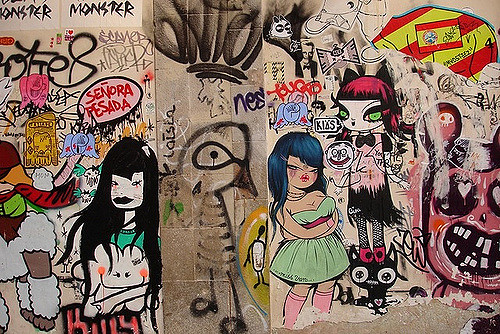Chapter 3. Culture

Learning Objectives
- Differentiate between the concepts ‘culture’ and ‘society.’
- Compare biological and cultural explanations of human behaviour.
- Contrast the concepts cultural universalism, cultural relativism, ethnocentrism, and androcentrism.
- Examine the policy of multiculturalism as a solution to the problem of cultural diversity and conflict.
- Define the basic elements of culture: values, beliefs, attitudes, norms and practices.
- Explain the significance of symbols and language to a culture.
- Describe the Sapir-Whorf hypothesis.
- Distinguish material and non-material culture.
3.3. Culture as Innovation: Pop Culture, Subculture, and Global Culture
- Distinguish two modes of culture: innovation and restriction.
- Describe the distinction between high culture, pop culture, and postmodern culture.
- Differentiate between subculture and counterculture.
- Understand the role of globalization in cultural change and local lived experience.
3.4. Culture as Restriction: Rationalization and Commodification
- Describe the ways culture restricts social life.
- Explain the implications of rationalization and consumerism.
3.5. Theoretical Perspectives on Culture
- Discuss the major theoretical approaches to cultural interpretation.
Introduction to Culture

Are there rules for eating at McDonald’s? Generally, people do not think about rules in a fast food restaurant because they are designed to be casual, quick, and convenient. In fact it is a tightly scripted activity. If one looks around a fast food restaurant on a typical weekday, they will see people acting as if they were trained for the role of fast food customer. They stand in line, pick their items from overhead menus before they order, swipe debit cards to pay, and stand to one side to collect trays of food. After a quick meal, customers wad up their paper wrappers and toss them into garbage cans. This is a food system or culture that has become highly rationalized in Max Weber’s terms, so much so that the sociologist George Ritzer (2009) uses it to describe the McDonaldization of society (See Chapter 7. Groups and Organizations). Customers’ movement through this fast food routine is orderly and predictable, even if no rules are posted and no officials are there to direct the process.
To gain insight into these unwritten rules, think about what would happen if you suddenly behaved according to some other standards. This would be doing what ethnomethodologists call a breaching experiment: deliberately disrupting social norms in order to learn about them. For example: call ahead for reservations; ask the cashier detailed questions about the food’s ingredients or how it is prepared; barter over the price of the burgers; ask to have your meal served to you at your table; or throw your trash on the ground as you leave. Chances are you will elicit hostile responses from the restaurant employees and your fellow customers. Although the rules are not written down, you will have violated deep-seated tacit norms that govern behaviour in fast food restaurants.
This example reflects a broader theme in the culture of food and diet. What are the rules that govern what, when, and how we eat? Michael Pollan (2006), for example, contrasts the North American culture of fast food with the intact traditions of eating sit-down, family meals that still dominate in France and other European nations. Despite eating foods that many North Americans think of as unhealthy — butter, wheat, triple-cream cheese, foie gras, wine, etc. — the French, as a whole, remain healthier and less overweight than North Americans.
The French eat all sorts of supposedly unhealthy foods, but they do it according to a strict and stable set of rules: They eat small portions and don’t go back for seconds; they don’t snack; they seldom eat alone; and communal meals are long, leisurely affairs (Pollan, 2006).
Their cultural rules fix and constrain what people consider as food and how people consume food. The national cuisine and eating habits of France are well established, oriented to pleasure and tradition, and as Pollan argues, well integrated into French cultural life as a whole.

In North America, on the other hand, fast food is just the tip of an iceberg with respect to a larger crisis of diet. Increasing levels of obesity and eating disorders are coupled with an increasing profusion of health diets, weight reducing diets, and food fads. While an alarming number of North American meals are eaten in cars (19%, according to Pollan), the counter-trend is the obsession with nutritional science. Instead of an orientation to food based on cultural tradition and pleasure, people are oriented to food in terms of its biochemical constituents (calories, proteins, fibers, carbohydrates, vitamins, omega fatty acids, saturated and unsaturated fats, etc.). There are Atkins diets, keto diets, zone diets, Mediterranean diets, paleolithic diets, vegan diets, gluten free diets, Weight Watchers diets, raw food diets, etc.; an endless proliferation that Pollan attributes to a fundamental anxiety that North Americans have about food and health. While each type of diet claims scientific evidence to support its health and other claims — evidence which is disturbingly contradictory — essentially the choice of diet revolves around the cultural meanings attributed to food and its nutritional components:
…that taste is not a true guide to what should be eaten; that one should not simply eat what one enjoys; that the important components of food cannot be seen or tasted, but are discernible only in scientific laboratories; and that experimental science has produced rules of nutrition that will prevent illness and encourage longevity (Levenstein as cited in Pollan, 2006).
It is important to note that food culture and diet are not infinitely malleable, however. There is an underlying biological reality of nutrition that defines the parameters of dietary choice. In his documentary Super Size Me (2004), Morgan Spurlock conducted a version of sociological field experiment by committing himself to eating only McDonald’s food for 30 days. As a result, he gained 24 pounds, increased his cholesterol and fat accumulation in his liver, and experienced mood swings and sexual dysfunction. It is clear that one cannot survive on fast food alone; although many teenagers and university students have been known to try.

Sociologists would argue that everything about fast food restaurants, choice of diet, and habits of food consumption reflects culture, the beliefs and behaviours that a social group shares. Diet is a product of culture. It is a product of the different meanings we attribute to food and to the relationship we have with our bodies. The significant point is that while diet is a functional response to the fundamental conditions of biological life, diet is also a tremendous site of innovation and diversity. Culture in general is a site of two opposing tendencies: one is the way that cultures around the world lay down sets of rules or norms which constrain, restrict, habitualize, and fix forms of life, allowing traditions and cultural ways to persist through time; the other is the way that cultures produce endlessly innovative and diverse solutions to problems like nutrition. Cultures both constrain social life and continually open up paths beyond constraints.
This raises the distinction between the terms “culture” and “society” and how sociologists conceptualize the relationship between them. In everyday conversation, people rarely distinguish between these terms, but they have different meanings, and the distinction is important to how sociologists examine culture. Culture refers to the beliefs, artifacts, and ways of life that a social group shares, whereas society is a group that interacts within a common bounded territory or region. To clarify, a culture represents the beliefs, practices, and material artifacts of a group — in other words, meaningful or meaning-laden components of group interaction — while a society represents the social structures, processes, and organization of the people who share those beliefs, practices, and material artifacts. Neither society nor culture could exist without the other, but sociologists can separate them analytically to gain insight into social life.
In this chapter, the relationship between culture and society is examined in greater detail, paying special attention to the elements and forces that shape culture, including cultural diversity and cultural changes. A final discussion touches on the different theoretical perspectives from which sociologists research culture.
Media Attributions
- Figure 3.1 Miss Van y Ciou by aikijuanma from Barcelona, Spain, via Wikimedia Commons, is used under a CC BY 2.0 licence.
- Figure 3.2 LEGO McDonald’s Little Cafe by Alan Boar, via Flickr, is used under a CC BY-SA 2.0 licence.
- Figure 3.3 Малиново крем брюле/ Creme brulee by Йоана Петрова / Joana Petrova, via Flickr, is used under a CC BY-NC-SA 2.0 licence.
- Figure 3.4 Kentucky Fried Chicken Instant Mashed Potato, 1974 by Roadsidepictures, via Flickr, is used under a CC BY-NC-ND 2.0 licence.

